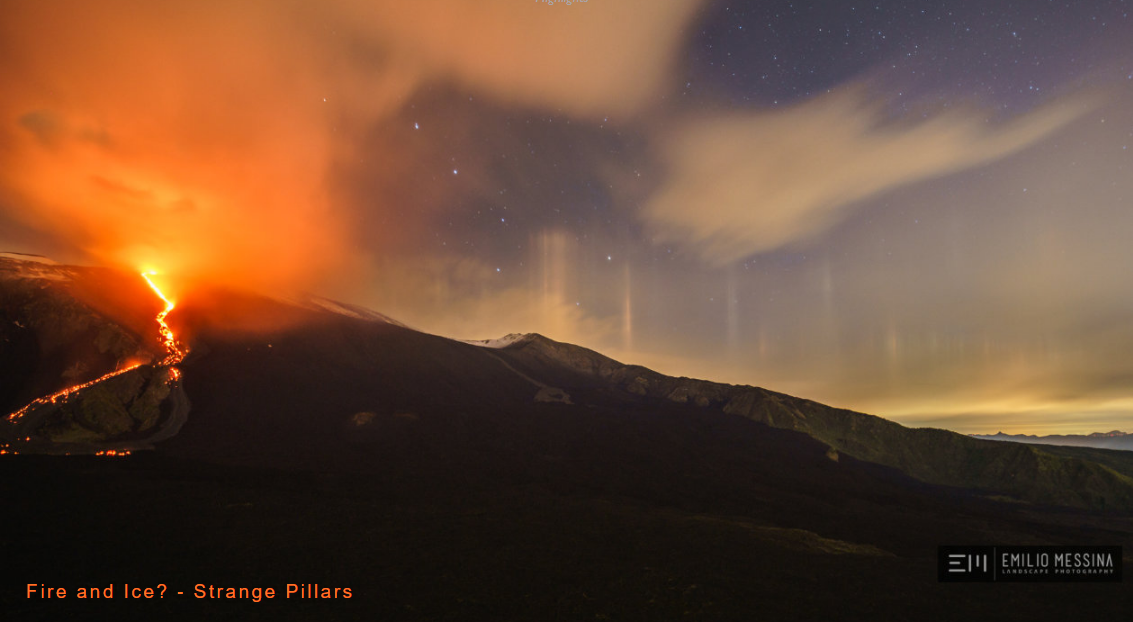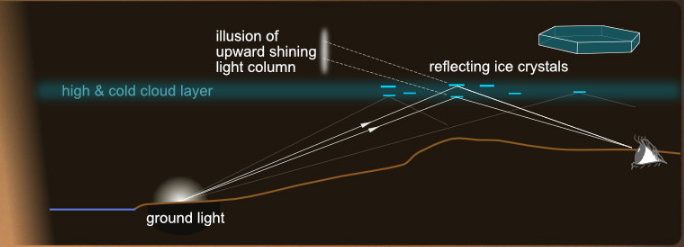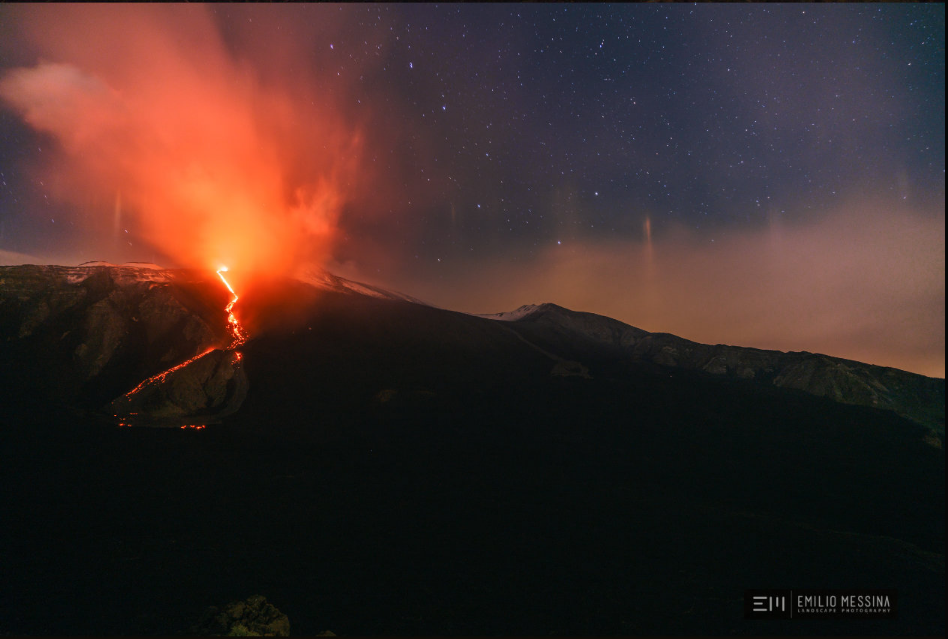Etna, Fire and Ice?
Etna, Fire and Ice? Unveiling the Mysteries of Light Pillars
When Emilio Messina, a landscape photographer, captured long exposure photos of an eruption of Mount Etna in Sicily, Italy on June 2, 2019, he discovered something intriguing. The images revealed the presence of vertical light columns surrounding the volcano. These peculiar formations resembled what is known as "light pillars," typically seen in frigid weather when street lights are reflected back downwards by low-level horizontal plate-shaped ice crystals. However, the sighting of ice in Sicily during the month of June raised eyebrows and sparked curiosity.
Upon closer investigation, experts were able to determine the height of the crystals responsible for creating these unusual light pillars. By analyzing the angular height of the columns above the astronomical horizon, which was approximately 16 degrees, and considering the distance of the ground lights on the north-west Sicilian coast, estimated to be up to 35 miles away, scientists calculated that the reflecting crystals were situated at an impressive altitude of around 27,000 feet. At such heights, the temperatures are certainly cold enough for ice crystals to form.
Shedding Light on the Phenomenon: Why Columns Instead of Spots?
One might wonder why these light pillars appear in column form rather than as individual spots. The answer lies in the characteristics of the cloud layer through which the light passes before reaching the observer's eye.
- When a thin cloud layer consists of precisely horizontal plate crystals, it acts as a perfect mirror, reflecting a realistic image of the ground lights. Although this phenomenon does occur, it is less common.
- On the other hand, a thicker cloud layer acts more like a stack of partially reflecting glass plates. This arrangement gives rise to column-shaped light pillars. Similarly, slightly wobbly plate crystals can also produce this effect.
The combination of these factors creates a captivating visual spectacle, where the fiery eruption of Mount Etna contrasts with the icy columns towering above it.
Exploring the Optical Illusion
The occurrence of light pillars around Mount Etna showcases a fascinating optical illusion. Although the phenomenon is not exclusive to this particular volcano, the juxtaposition of fire and ice adds an extra layer of intrigue. Here's a closer look at the mechanics behind this captivating display:
-
Temperature and Atmospheric Conditions: The presence of ice crystals in the atmosphere is crucial for the formation of light pillars. In cold weather, especially during winter, these crystals can form at varying altitudes, creating the necessary conditions for the phenomenon to occur.
-
Reflection and Refraction: When light from ground sources, such as street lights or city lights, encounters the ice crystals suspended in the air, it undergoes reflection and refraction. This interaction causes the light to scatter and create the illusion of vertical columns.
-
Plate-Shaped Crystals: The shape of the ice crystals plays a significant role in determining the appearance of the light pillars. In the case of light pillars observed around Mount Etna, the crystals are predominantly plate-shaped. This shape allows for a more organized reflection and refraction of light, resulting in distinct column formations.
-
Cloud Thickness: The thickness of the cloud layer through which the light passes influences the formation of columns instead of spots. Thicker clouds act as a series of partially reflecting glass plates, contributing to the columnar structure of the light pillars.
-
Wobbly Crystals: Even slight irregularities in the orientation or alignment of the plate-shaped ice crystals can contribute to the formation of columnar light pillars. These wobbly crystals introduce variations in the reflection and refraction process, further enhancing the illusion.
The Intersection of Fire and Ice
The juxtaposition of fiery volcanic activity and icy atmospheric phenomena around Mount Etna creates a captivating spectacle that captures the imagination. The contrast between the erupting volcano and the ethereal light pillars adds an element of wonder and intrigue to the scene.
The presence of ice crystals in the vicinity of an active volcano might seem counterintuitive, but it serves as a reminder of the diverse and complex nature of our atmosphere. While we typically associate ice formations with colder regions, the altitude and specific atmospheric conditions around Mount Etna create an environment where ice crystals can form, even in June.
A Natural Marvel: Appreciating Atmospheric Optics
The occurrence of light pillars around Mount Etna offers a glimpse into the world of atmospheric optics. These captivating displays remind us of the intricate interplay between light, weather conditions, and the composition of our atmosphere. By understanding the underlying mechanisms behind such phenomena, we gain a deeper appreciation for the natural marvels that surround us.
As we continue to explore and study atmospheric optics, we unlock a wealth of knowledge that contributes to our understanding of the world and the mysteries it holds. From the beauty of light pillars to the awe-inspiring phenomena witnessed in the skies, each discovery brings us closer to unraveling the complexities of our atmosphere and the wonders it has to offer.
So, the next time you find yourself gazing at a sky filled with extraordinary optical phenomena, take a moment to marvel at the intricate workings of nature and the remarkable intersections between fire and ice.

Emilio Messina ( Landscape Photography ) was taking long exposure photos of an eruption of Mount Etna in Sicily, Italy on June 2, 2019. The exposures revealed vertical light columns seemingly around the volcano.
They look like 'light pillars', seen in very cold weather when street lights are reflected back downwards by low level horizontal plate shaped ice crystals.. But ice in Sicily in June!?
Fortunately we cancalculate the height of any crystals. The Plough's stars in the background give the columns' angular height at ~16 degrees above the astronomical horizon. Theground lights could be up to 35 miles distant on the north-west Sicilian coast. Put that together and the height of the reflecting crystals comes out at roughly 27,000 feet. It's certainly cold enough up there for ice crystals.
Unusual light pillars from ice far above fiery Etna.

Why columns rather than spots?
A thin cloud layer with exactly horizontal plate crystals would act like a perfect mirror and give a realistic reflection of the the ground lights. This sometimes happens.
A thicker cloud layer acts like a stack of partially reflecting glass plates and that gives columns. So do slightly wobbly plate crystals.


Note: this article has been automatically converted from the old site and may not appear as intended. You can find the original article here.
Reference Atmospheric Optics
If you use any of the definitions, information, or data presented on Atmospheric Optics, please copy the link or reference below to properly credit us as the reference source. Thank you!
-
<a href="https://atoptics.co.uk/blog/etna-fire-and-ice/">Etna, Fire and Ice? </a>
-
"Etna, Fire and Ice? ". Atmospheric Optics. Accessed on November 26, 2024. https://atoptics.co.uk/blog/etna-fire-and-ice/.
-
"Etna, Fire and Ice? ". Atmospheric Optics, https://atoptics.co.uk/blog/etna-fire-and-ice/. Accessed 26 November, 2024
-
Etna, Fire and Ice? . Atmospheric Optics. Retrieved from https://atoptics.co.uk/blog/etna-fire-and-ice/.